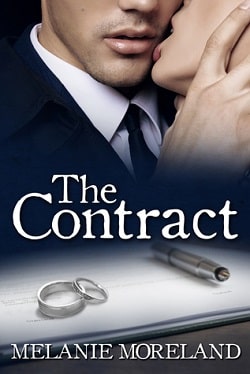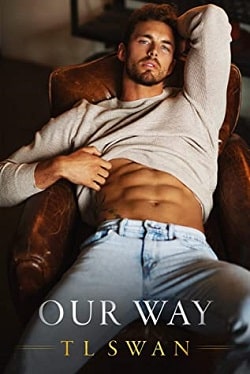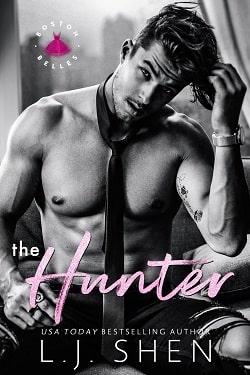“Was it everything you wanted? The picket fence? The PTA?”
“What’s the PTA? Some sort of cult?”
“Pretty much.” I waited as he navigated a roundabout.
“Yes,” he said finally. “I got my rose-covered cottage and my happily-almost-after.” He flicked me a sideways look. “You?”
My mind skimmed like a bird over the past thirty—almost forty—years. Jesus, where had the time gone? The scenes passed in front of my eyes like a movie reel, some in faded black-and-white, some in a riot of Technicolor, the places I’d seen, the people I’d known.
“I have had exactly the life I wanted for myself,” I told him.
He was quiet a long moment. “I’m glad.”
“You know,” I said lightly, “I always wondered if you were really that upset when I turned you down. I half expected you to chase after me and drag me to the altar against my will, but you never did.”
“Oh, I thought about it,” he admitted with a smile. “But I knew if I pushed, you would wind up hating me for it, and I wasn’t about to take that chance. Besides, I always figured we’d find our way back to each other in the end.”
I couldn’t form an answer to that so it was just as well thatwe’d arrived. He eased to a stop in the drop-off lane at the station and I opened my door. I cleared my throat and managed to sound passably normal. “It was good of you to come.”
“There was never a chance I wouldn’t,” he said. He grinned, and I smiled back, meaning it.
“Thanks for the ride, English.”
“See you on the other side.”
CHAPTER THIRTY-EIGHT
It had rained in the late afternoon and the pavement smelled like wet cement. I made my way on foot from the station, turning the corner to see Tollemache’s lit up like a birthday cake. The windows facing the street were permanently shuttered, but lanterns, glowing softly, hung on either side of the door. Someone had set out a line of boxwood topiaries hung with fairy lights—an intern, probably. The door was propped open and a decorative young man dressed in a tight plaid suit was standing just inside, repeating, “Welcome to Tollemache’s,” every five or six seconds like he was stuck on a loop.
I passed inside and grabbed a glass of champagne from a girl circulating with a tray. It was early yet, but the room was buzzing with anticipation and prospective buyers crowded around the paintings. I stood against a wall, letting the crowds pass in front of me as I sipped my champagne and took stock.
Tollemache’s had taken the mock Tudor theme to theextreme. The interior was designed to resemble the Globe Theatre, with an open stage in the center surrounded by galleried walkways. The upper gallery was reserved for sellers and Tollemache’s executives, with the lower gallery providing a sort of corral for onlookers and the press. There was even a wide stretch of wine-colored velvet curtains along the back of the stage with a podium set just in front for the auctioneer.
Next to the podium stood an empty easel. It was flanked by a long table outfitted with a phone bank. Most auction houses had a large computerized sign to display the reserve and current bids in various currencies, but Tollemache’s was too old-school for that. The reserve and current were shown in pounds sterling only, and if you didn’t know your euros from your yen, well, sucks to be you, I guess. More than one bidder had gotten burned by failing to calculate the exchange correctly, but Tollemache’s got away with it because it was supposed to be part of their eccentric charm.
After I’d downed half my drink, I joined the queue to see the paintings. It moved quicker than I expected and not many people were focused on theSheba. They wanted the big-money pictures—the pushing to see the O’Keeffe had resulted in a shoving match. But theShebahung in a smaller alcove, grouped quietly with Vallayer-Coster’s pineapple still life. The pineapple was... well, it was a pineapple—yellow and green and surrounded by an assortment of other fruits and a sullen-looking lobster.
TheShebawas different. She had the quality of all of Anguissola’s women. They stare out with their painted eyes—not at you, through you. They stare so long and so hard youalmost believe they’re real and you’re the creation from some artist’s imagination. They’re entirely alive in the way only great art can be. Most of Anguissola’s portraits have black backgrounds, but to set off the queen’s dark skin, she had painted a domestic scene behind, the soft white of the bedsheets a reminder of just what the queen had been doing—and who. Solomon’s naked thigh was a tanned olive against the tumbled linens, his muscles relaxed with fatigue and satisfaction. Sheba’s eyes were calm and watchful, a tiny smile playing over her lips. A spilled pitcher of water alluded to the story that Solomon had tricked her into bed, making her promise to sleep with him if she took anything belonging to him. Then he fed her spicy food, ensuring she would need to help herself to a cup of water in the night—a tiny theft with enormous consequences.
This Sheba didn’t look like a woman who’d been tricked into sex. She looked like a woman who had gotten exactly what she wanted. The king’s weapons were lying on the floor, useless and abandoned, a signal that war had been vanquished by love. Everything about the painting was sexy, from the glow on Sheba’s skin to the bowl of ripe peaches next to the bed.
I bent near to the bottom left corner, but I couldn’t find the repair. If you didn’t know it had been shot, you’d never suspect a bullet had once pierced the canvas. I was sad that the Provenance department had never unearthed any survivors from the family who had last owned it, but I was glad theShebawas getting out in the world again. She deserved to be seen.
As I straightened, I realized someone was standing at my elbow. She was tall and wearing five-inch stilettos that put her easily over six feet. Her pantsuit was white, the trousers tight through the thighs but flaring from the knees. She wasn’t wearing a shirt under the low-cut white blazer, just a thin gold chain that clasped under her breasts and behind her neck. Her hoop earrings were diamond, as were the rings on her fingers. Her Afro formed a perfect circle around her head and she had frosted the ends in gold, giving her a glimmering halo. Her lips were the same shimmering gold. A flunky stood behind her holding a custom oversized white ostrich Birkin bag that Helen would have given her right arm for. It took me a minute to place her, and then it came to me—Mona Rae. The last time I’d seen her, she had been on the cover ofEntertainment Weeklyfor winning the Golden Globe for Best Director.
A bell rang and the music system was flooded with the sound of Elgar’s “Trumpet Voluntary,” Tollemache’s signature piece. Like cattle, the bidders made their way towards the seating area. Heavy wine-red ropes kept the journalists and tourists at a distance, and girls wearing plain black dresses and holding clipboards were stationed at each gap in the ropes. They directed every bidder to a specific numbered seat, ticking people off as they passed. Mona Rae, I noticed, was sitting right up front, perfectly positioned for journalists to get a spectacular photo of her when theShebamade an appearance.
But the Anguissola wasn’t coming up until the second lot. The crowd settled into their seats, the air vibrating withenergy. Suddenly, the music crashed to a crescendo and the red velvet curtains parted. Behind was a line of porters dressed in racing green coveralls, Tollemache’s logo stitched in gold on each breast pocket. Making her way through the gauntlet of porters was the auctioneer, Lilja Koskela.
She was fortyish and thin like a whippet with a nose like one too. I didn’t know Finns came with black hair, but this one did, and she was sporting a pair of Verdura necklaces—heavy gold chains dotted with a variety of gemstones. Later I looked them up and found out they were worth about eighty grand. If I’d known that at the time, I might have at least considered branching into jewel theft. Lilja Koskela strode to the podium like an Oscar favorite accepting her statue. She looked coolly at the crowd and made a few announcements, her English only barely tinged with a Finnish vowel here and there.
I was half listening to her as my gaze wandered over the crowd. I would have missed him if it hadn’t been for the quick flash of white cuff. He was dressed with nondescript good taste, plain Burberry trench, dull plaid scarf, navy trilby pulled down over his brow. I sipped at my champagne and waited. He was discreet; only another pro would have noticed the small, sweeping scans he made of the crowd. But I kept behind a pillar, one of the floodlights positioned just above me, throwing me into shadow.
At the podium, Lilja Koskela finished her announcements and there was a sudden rousing blare of Handel’sWater Musicas a pair of porters carried in Vallayer-Coster’sPineapple. They set it on the easel and the crowd leaned forward. It was the onlystill life in the group and about as exciting as you’d expect a pineapple to be. But Koskela was a born storyteller, and by the time she finished describing the composition and the provenance, bidders were reaching for their paddles.
She started them at £400,000 and suddenly we were off to the races, bids flying all over the room. At first, it seemed like there were eight different bidders, but some of them may have been chandelier bids—a technique Mary Alice had explained. It’s when the auctioneer pretends to accept a bid from a phantom bidder in order to drive the price up. It was a risky proposition if you weren’t sure someone in the room would top it, but Koskela worked the crowd, milking them like dairy cows until she got them up to £750,000. At an exchange rate of one pound sterling to $1.308, plus fees, thePineapplemight look like SpongeBob’s house, but it was working its way towards a cool million.
She brought the hammer down at £775,000 and the crowd went nuts, at least nuts for an auction crowd. There was a brief interlude before the music blared—Handel again.The Arrival of the Queen of Sheba.Koskela read through the provenance. She opened the bidding at £300,000. There were a number of bidders to start—a few museums, a couple of private dealers. Representations of Black women in Renaissance art weren’t all that common, after all. And Anguissola was a good bet to appreciate in value. She wasn’t well-known outside the art world, but female artists were increasingly in vogue and Anguissola was one of the best.















